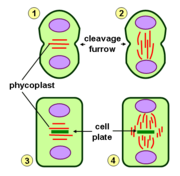
Phycoplast
Encyclopedia

Microtubule
Microtubules are a component of the cytoskeleton. These rope-like polymers of tubulin can grow as long as 25 micrometers and are highly dynamic. The outer diameter of microtubule is about 25 nm. Microtubules are important for maintaining cell structure, providing platforms for intracellular...
structure observed during cytokinesis
Cytokinesis
Cytokinesis is the process in which the cytoplasm of a single eukaryotic cell is divided to form two daughter cells. It usually initiates during the late stages of mitosis, and sometimes meiosis, splitting a binucleate cell in two, to ensure that chromosome number is maintained from one generation...
in members of the Chlorophyceae
Chlorophyceae
The Chlorophyceae are one of the classes of green algae, distinguished mainly on the basis of ultrastructural morphology. For example the chlorophycean CW clade, and chlorophycean DO clade, are defined by the arrangement of their flagella. Members of the CW clade have flagella that are displaced...
, the largest class of green algae
Algae
Algae are a large and diverse group of simple, typically autotrophic organisms, ranging from unicellular to multicellular forms, such as the giant kelps that grow to 65 meters in length. They are photosynthetic like plants, and "simple" because their tissues are not organized into the many...
.
Cytokinesis in green algae occurs via a diverse range of mechanisms, including cleavage furrow
Cleavage furrow
In cell biology, the cleavage furrow is the indentation that begins the process of cleavage, by which animal and some algal cells undergo cytokinesis. The same proteins responsible for muscle contraction, actin and myosin begin the process of forming the cleavage furrow. This can only happen in...
s in some algae and cell plate
Cell plate
thumb|300px|Phragmoplast and cell plate formation in a plant cell during cytokinesis. Left side: Phragmoplast forms and cell plate starts to assemble in the center of the cell. Toawards the right: Phragmoplast enlarges in a donut-shape towards the outside of the cell, leaving behind mature cell...
s in others. Some green algae of the class Charophyceae
Charophyceae
Charophyceae is a taxon of green algae whose exact rank is the matter of some current debate. Some botanists recommend expanding the existing plant kingdom to include charophyceans and chlorophytes while others consider Charophyceae to be a class within either the divisions Chlorophyta,...
use phragmoplast
Phragmoplast
thumb|300px|Phragmoplast and cell plate formation in a plant cell during cytokinesis. Left side: Phragmoplast forms and cell plate starts to assemble in the center of the cell. Towards the right: Phragmoplast enlarges in a donut-shape towards the outside of the cell, leaving behind mature cell...
s similar to those in embryophytes to organize and guide the growing cell plate. In these algae, the microtubules of the telophase
Telophase
Telophase from the ancient Greek "τελος" and "φασις" , is a stage in both meiosis and mitosis in a eukaryotic cell. During telophase, the effects of prophase and prometaphase events are reversed. Two daughter nuclei form in the cell. The nuclear envelopes of the daughter cells are formed from the...
spindle
Mitotic spindle
In cell biology, the spindle fibers are the structure that separates the chromosomes into the daughter cells during cell division. It is part of the cytoskeleton in eukaryotic cells...
give rise to the phragmoplast and are oriented perpendicular to the plane of cell division and the forming cell plate. The growth of the cell plate eventually disrupts the telophase spindle (see case 4 in picture).
In the Chlorophyceae
Chlorophyceae
The Chlorophyceae are one of the classes of green algae, distinguished mainly on the basis of ultrastructural morphology. For example the chlorophycean CW clade, and chlorophycean DO clade, are defined by the arrangement of their flagella. Members of the CW clade have flagella that are displaced...
, the most common form of cell division occurs via a phycoplast. In these algae, the spindle collapses and a new system of microtubules forms that is oriented in parallel to the plane of cell division. This phycoplast can be observed in algae undergoing cytokinesis via cleavage furrow (case 1 in picture) as well as algae utilizing a cell plate (case 3 in picture). The phycoplast may play a role in assuring that the plane of cell division will pass between the two daughter nuclei. Typically, these algae undergo "closed" mitosis
Mitosis
Mitosis is the process by which a eukaryotic cell separates the chromosomes in its cell nucleus into two identical sets, in two separate nuclei. It is generally followed immediately by cytokinesis, which divides the nuclei, cytoplasm, organelles and cell membrane into two cells containing roughly...
where the nuclear envelope
Nuclear envelope
A nuclear envelope is a double lipid bilayer that encloses the genetic material in eukaryotic cells. The nuclear envelope also serves as the physical barrier, separating the contents of the nucleus from the cytosol...
persists throughout mitosis.

